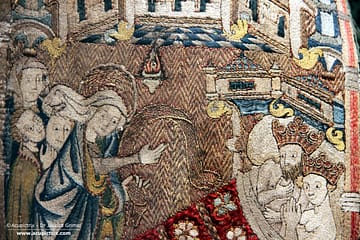In September 2019, I visited the exquisite exhibition “Fili d’oro e dipinti di seta” in the Castello del Buonconsiglio in Trento, Northern Italy. Together with the 2015 exhibition in the Catharijneconvent and the 2016 Opus Anglicanum exhibition in the V&A, this was one of those ‘must-see’ exhibitions. This one visit provided me with research material for several years. Especially as I was allowed to take as many pictures as I liked. As long as you don’t use flash, the textiles don’t mind at all. Today, we are going to look at some early Venetian embroidery. It includes some techniques unique to the Venetian embroidery workshops. Let’s dive in!

As you can see in the picture above, the cope is no longer an actual vestment. Only the mutilated orphrey panels have survived. They were used secondarily on an antependium, which was probably made at the end of the 19th century. The orphrey panels were removed from this newer antependium in 2006 during restoration and applied to a neutral backing. The orphrey panels represent three pairs of saints facing each other, a smaller square orphrey that would have sat on the wearer’s neck and connected the two sets of three. There’s also part of the cope hood with the Coronation of the Virgin. Identifiable among the saints are: John the Baptist (top left), James the Great (top right), Bartholomew or Peter (middle left) and Saint Jerome (square in the middle). The embroideries were made in a Venetian embroidery workshop around AD 1410-1417.

When you look at the figures’ outer garments, it seems they have measles. These ‘measles’ are actually characteristic of Venetian embroidery. The ‘measles’ are made by covering a metal disc, with a central or off-centre hole (think spangle/sequin), with gold thread. Some discs are made of pressed paper. The gold threads that cover the discs are worked in gimped couching, but with an underside couching stitch. Proof again that underside couching is not exclusively English. Keeping the gold threads from rolling off the edges of the padding was probably no small feat!

Another characteristic of Venetian embroidery is the elaborate dimensional frame around the orphreys. String padding is used to achieve the different textures. By using strings with various thicknesses, they could create several ‘levels’ in the frame. You can find an embroidery tutorial for the technique here.
In general, many different embroidery techniques are used in these Italian embroideries from the Middle Ages. There is beautiful (directional) split stitch in silk, laid work, diaper couching, and trellises. Or nué is absent, as that was probably invented in the Southern Netherlands/Northern France and had not yet made its way to Italy.
Literature
Prá, Laura Dal; Carmignani, Marina; Peri, Paolo (Eds.) (2019): Fili d’oro e dipinti di seta. Velluti e ricami tra Gotico e Rinascimento. Trento: Castello del Buonconsiglio.



0 Comments